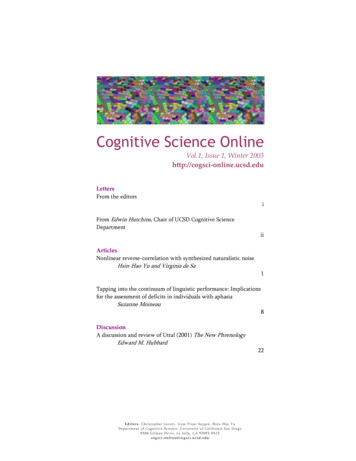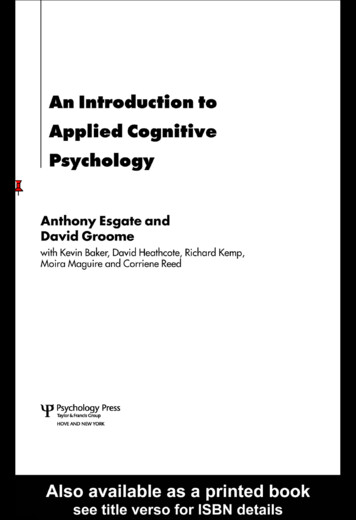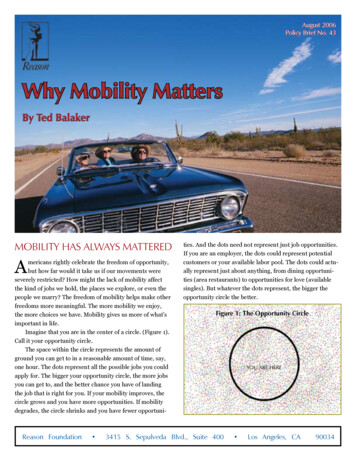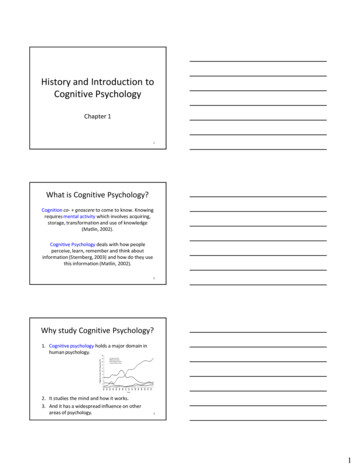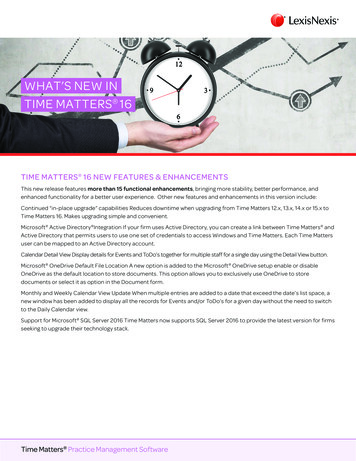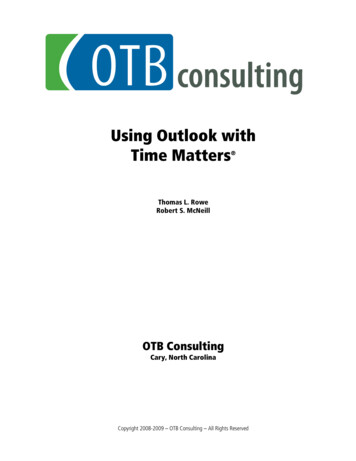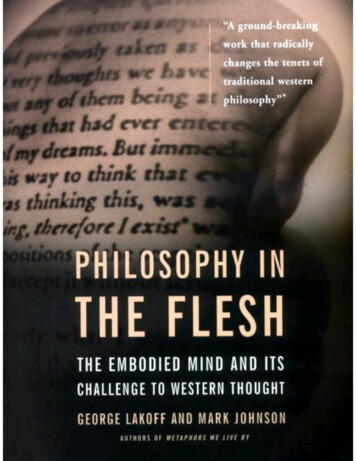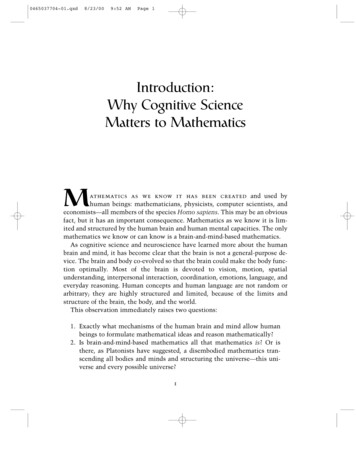
Transcription
0465037704-01.qxd8/23/009:52 AMPage 1Introduction:Why Cognitive ScienceMatters to MathematicsMathematics as we know it has been created and used byhuman beings: mathematicians, physicists, computer scientists, andeconomists—all members of the species Homo sapiens. This may be an obviousfact, but it has an important consequence. Mathematics as we know it is limited and structured by the human brain and human mental capacities. The onlymathematics we know or can know is a brain-and-mind-based mathematics.As cognitive science and neuroscience have learned more about the humanbrain and mind, it has become clear that the brain is not a general-purpose device. The brain and body co-evolved so that the brain could make the body function optimally. Most of the brain is devoted to vision, motion, spatialunderstanding, interpersonal interaction, coordination, emotions, language, andeveryday reasoning. Human concepts and human language are not random orarbitrary; they are highly structured and limited, because of the limits andstructure of the brain, the body, and the world.This observation immediately raises two questions:1. Exactly what mechanisms of the human brain and mind allow humanbeings to formulate mathematical ideas and reason mathematically?2. Is brain-and-mind-based mathematics all that mathematics is? Or isthere, as Platonists have suggested, a disembodied mathematics transcending all bodies and minds and structuring the universe—this universe and every possible universe?1
0465037704-01.qxd8/23/009:52 AMPage 22IntroductionQuestion 1 asks where mathematical ideas come from and how mathematical ideas are to be analyzed from a cognitive perspective. Question 1 is a scientific question, a question to be answered by cognitive science, theinterdisciplinary science of the mind. As an empirical question about thehuman mind and brain, it cannot be studied purely within mathematics. Andas a question for empirical science, it cannot be answered by an a priori philosophy or by mathematics itself. It requires an understanding of human cognitiveprocesses and the human brain. Cognitive science matters to mathematics because only cognitive science can answer this question.Question 1 is what this book is mostly about. We will be asking how normalhuman cognitive mechanisms are employed in the creation and understandingof mathematical ideas. Accordingly, we will be developing techniques of mathematical idea analysis.But it is Question 2 that is at the heart of the philosophy of mathematics. Itis the question that most people want answered. Our answer is straightforward: Theorems that human beings prove are within a human mathematicalconceptual system. All the mathematical knowledge that we have or can have is knowledgewithin human mathematics. There is no way to know whether theorems proved by human mathematicians have any objective truth, external to human beings or anyother beings.The basic form of the argument is this:1. The question of the existence of a Platonic mathematics cannot be addressed scientifically. At best, it can only be a matter of faith, much likefaith in a God. That is, Platonic mathematics, like God, cannot in itselfbe perceived or comprehended via the human body, brain, and mind.Science alone can neither prove nor disprove the existence of a Platonicmathematics, just as it cannot prove or disprove the existence of a God.2. As with the conceptualization of God, all that is possible for human beings is an understanding of mathematics in terms of what the humanbrain and mind afford. The only conceptualization that we can have ofmathematics is a human conceptualization. Therefore, mathematics aswe know it and teach it can only be humanly created and humanly conceptualized mathematics.
0465037704-01.qxd8/23/009:52 AMPage 3Introduction33. What human mathematics is, is an empirical scientific question, not amathematical or a priori philosophical question.4. Therefore, it is only through cognitive science—the interdisciplinarystudy of mind, brain, and their relation—that we can answer the question: What is the nature of the only mathematics that human beingsknow or can know?5. Therefore, if you view the nature of mathematics as a scientific question, then mathematics is mathematics as conceptualized by human beings using the brain’s cognitive mechanisms.6. However, you may view the nature of mathematics itself not as a scientific question but as a philosophical or religious one. The burden ofscientific proof is on those who claim that an external Platonic mathematics does exist, and that theorems proved in human mathematics areobjectively true, external to the existence of any beings or any conceptual systems, human or otherwise. At present there is no known way tocarry out such a scientific proof in principle.This book aspires to tell you what human mathematics, conceptualized viahuman brains and minds, is like. Given the present and foreseeable state of ourscientific knowledge, human mathematics is mathematics. What human mathematical concepts are is what mathematical concepts are.We hope that this will be of interest to you whatever your philosophical orreligious beliefs about the existence of a transcendent mathematics.There is an important part of this argument that needs further elucidation.What accounts for what the physicist Eugene Wigner has referred to as “the unreasonable effectiveness of mathematics in the natural sciences” (Wigner,1960)? How can we make sense of the fact that scientists have been able to findor fashion forms of mathematics that accurately characterize many aspects ofthe physical world and even make correct predictions? It is sometimes assumedthat the effectiveness of mathematics as a scientific tool shows that mathematics itself exists in the structure of the physical universe. This, of course, isnot a scientific argument with any empirical scientific basis.We will take this issue up in detail in Part V of the book. Our argument, inbrief, will be that whatever “fit” there is between mathematics and the worldoccurs in the minds of scientists who have observed the world closely, learnedthe appropriate mathematics well (or invented it), and fit them together (ofteneffectively) using their all-too-human minds and brains.
0465037704-01.qxd48/23/009:52 AMPage 4IntroductionFinally, there is the issue of whether human mathematics is an instance of,or an approximation to, a transcendent Platonic mathematics. This positionpresupposes a nonscientific faith in the existence of Platonic mathematics. Wewill argue that even this position cannot be true. The argument rests on analyses we will give throughout this book to the effect that human mathematicsmakes fundamental use of conceptual metaphor in characterizing mathematical concepts. Conceptual metaphor is limited to the minds of living beings.Therefore, human mathematics (which is constituted in significant part by conceptual metaphor) cannot be a part of Platonic mathematics, which—if it existed—would be purely literal.Our conclusions will be:1. Human beings can have no access to a transcendent Platonic mathematics, if it exists. A belief in Platonic mathematics is therefore a matter of faith, much like religious faith. There can be no scientificevidence for or against the existence of a Platonic mathematics.2. The only mathematics that human beings know or can know is, therefore, a mind-based mathematics, limited and structured by humanbrains and minds. The only scientific account of the nature of mathematics is therefore an account, via cognitive science, of human mindbased mathematics. Mathematical idea analysis provides such anaccount.3. Mathematical idea analysis shows that human mind-based mathematics uses conceptual metaphors as part of the mathematics itself.4. Therefore human mathematics cannot be a part of a transcendent Platonic mathematics, if such exists.These arguments will have more weight when we have discussed in detailwhat human mathematical concepts are. That, as we shall see, depends uponwhat the human body, brain, and mind are like. A crucial point is the argumentin (3)—that conceptual metaphor structures mathematics as human beings conceptualize it. Bear that in mind as you read our discussions of conceptualmetaphors in mathematics.Recent Discoveries about the Nature of MindIn recent years, there have been revolutionary advances in cognitive science—advances that have an important bearing on our understanding of mathematics.Perhaps the most profound of these new insights are the following:
0465037704-01.qxd8/23/009:52 AMPage 5Introduction51. The embodiment of mind. The detailed nature of our bodies, our brains,and our everyday functioning in the world structures human conceptsand human reason. This includes mathematical concepts and mathematical reason.2. The cognitive unconscious. Most thought is unconscious—not repressed in the Freudian sense but simply inaccessible to direct conscious introspection. We cannot look directly at our conceptual systemsand at our low-level thought processes. This includes most mathematical thought.3. Metaphorical thought. For the most part, human beings conceptualizeabstract concepts in concrete terms, using ideas and modes of reasoninggrounded in the sensory-motor system. The mechanism by which theabstract is comprehended in terms of the concrete is called conceptualmetaphor. Mathematical thought also makes use of conceptualmetaphor, as when we conceptualize numbers as points on a line.This book attempts to apply these insights to the realm of mathematicalideas. That is, we will be taking mathematics as a subject matter for cognitivescience and asking how mathematics is created and conceptualized, especiallyhow it is conceptualized metaphorically.As will become clear, it is only with these recent advances in cognitive science that a deep and grounded mathematical idea analysis becomes possible. Insights of the sort we will be giving throughout this book were not evenimaginable in the days of the old cognitive science of the disembodied mind, developed in the 1960s and early 1970s. In those days, thought was taken to be themanipulation of purely abstract symbols and all concepts were seen as literal—free of all biological constraints and of discoveries about the brain. Thought,then, was taken by many to be a form of symbolic logic. As we shall see inChapter 6, symbolic logic is itself a mathematical enterprise that requires acognitive analysis. For a discussion of the differences between the old cognitivescience and the new, see Philosophy in the Flesh (Lakoff & Johnson, 1999) andReclaiming Cognition (Núñez & Freeman, eds., 1999).Mathematics is one of the most profound and beautiful endeavors of the imagination that human beings have ever engaged in. Yet many of its beauties andprofundities have been inaccessible to nonmathematicians, because most of thecognitive structure of mathematics has gone undescribed. Up to now, even thebasic ideas of college mathematics have appeared impenetrable, mysterious,and paradoxical to many well-educated people who have approached them. We
0465037704-01.qxd68/23/009:52 AMPage 6Introductionbelieve that cognitive science can, in many cases, dispel the paradoxes and clearaway the shrouds of mystery to reveal in full clarity the magnificence of thoseideas. To do so, it must reveal how mathematics is grounded in embodied experience and how conceptual metaphors structure mathematical ideas.Many of the confusions, enigmas, and seeming paradoxes of mathematicsarise because conceptual metaphors that are part of mathematics are not recognized as metaphors but are taken as literal. When the full metaphorical character of mathematical concepts is revealed, such confusions and apparentparadoxes disappear.But the conceptual metaphors themselves do not disappear. They cannot beanalyzed away. Metaphors are an essential part of mathematical thought, notjust auxiliary mechanisms used for visualization or ease of understanding. Consider the metaphor that Numbers Are Points on a Line. Numbers don’t have tobe conceptualized as points on a line; there are conceptions of number that arenot geometric. But the number line is one of the most central concepts in all ofmathematics. Analytic geometry would not exist without it, nor wouldtrigonometry.Or take the metaphor that Numbers Are Sets, which was central to the Foundations movement of early-twentieth-century mathematics. We don’t have toconceptualize numbers as sets. Arithmetic existed for over two millennia without this metaphor—that is, without zero conceptualized as being the empty set,1 as the set containing the empty set, 2 as the set containing 0 and 1, and so on.But if we do use this metaphor, then forms of reasoning about sets can alsoapply to numbers. It is only by virtue of this metaphor that the classical Foundations of Mathematics program can exist.Conceptual metaphor is a cognitive mechanism for allowing us to reasonabout one kind of thing as if it were another. This means that metaphor is notsimply a linguistic phenomenon, a mere figure of speech. Rather, it is a cognitive mechanism that belongs to the realm of thought. As we will see later in thebook, “conceptual metaphor” has a technical meaning: It is a grounded, inference-preserving cross-domain mapping—a neural mechanism that allows us touse the inferential structure of one conceptual domain (say, geometry) to reasonabout another (say, arithmetic). Such conceptual metaphors allow us to applywhat we know about one branch of mathematics in order to reason about another branch.Conceptual metaphor makes mathematics enormously rich. But it also bringsconfusion and apparent paradox if the metaphors are not made clear or are takento be literal truth. Is zero a point on a line? Or is it the empty set? Or both? Oris it just a number and neither a point nor a set? There is no one answer. Each
0465037704-01.qxd8/23/009:52 AMPage 7Introduction7answer constitutes a choice of metaphor, and each choice of metaphor providesdifferent inferences and determines a different subject matter.Mathematics, as we shall see, layers metaphor upon metaphor. When a single mathematical idea incorporates a dozen or so metaphors, it is the job of thecognitive scientist to tease them apart so as to reveal their underlying cognitivestructure.This is a task of inherent scientific interest. But it also can have an importantapplication in the teaching of mathematics. We believe that revealing the cognitive structure of mathematics makes mathematics much more accessible andcomprehensible. Because the metaphors are based on common experiences, themathematical ideas that use them can be understood for the most part in everyday terms.The cognitive science of mathematics asks questions that mathematics doesnot, and cannot, ask about itself. How do we understand such basic concepts asinfinity, zero, lines, points, and sets using our everyday conceptual apparatus?How are we to make sense of mathematical ideas that, to the novice, are paradoxical—ideas like space-filling curves, infinitesimal numbers, the point at infinity, and non-well-founded sets (i.e., sets that “contain themselves” asmembers)?Consider, for example, one of the deepest equations in all of mathematics, theEuler equation, epi 1 0, e being the infinite decimal 2.718281828459045. . . ,a far-from-obvious number that is the base for natural logarithms. This equationis regularly taught in elementary college courses. But what exactly does it mean?We are usually told that an exponential of the form qn is just the number qmultiplied by itself n times; that is, q · q · . . . · q. This makes perfect sense for25, which would be 2 · 2 · 2 · 2 · 2, which multiplies out to 32. But this definitionof an exponential makes no sense for epi. There are at least three mysteries here.1. What does it mean to multiply an infinite decimal like e by itself? If youthink of multiplication as an algorithmic operation, where do you start?Usually you start the process of multiplication with the last digit on theright, but there is no last digit in an infinite decimal.2. What does it mean to multiply any number by itself p times? p is another infinite nonrepeating decimal. What could “p times” for performing an operation mean?3. And even worse, what does it mean to multiply a number by itself animaginary (Ö–1) number of times?
0465037704-01.qxd88/23/009:52 AMPage 8IntroductionAnd yet we are told that the answer is –1. The typical proof is of no help here.It proves that epi 1 0 is true, but it does not tell you what epi means! In thecourse of this book, we will.In this book, unlike most other books about mathematics, we will be concerned not just with what is true but with what mathematical ideas mean, howthey can be understood, and why they are true. We will also be concerned withthe nature of mathematical truth from the perspective of a mind-based mathematics.One of our main concerns will be the concept of infinity in its various manifestations: infinite sets, transfinite numbers, infinite series, the point at infinity, infinitesimals, and objects created by taking values of sequences “atinfinity,” such as space-filling curves. We will show that there is a single BasicMetaphor of Infinity that all of these are special cases of. This metaphor originates outside mathematics, but it appears to be the basis of our understandingof infinity in virtually all mathematical domains. When we understand theBasic Metaphor of Infinity, many classic mysteries disappear and the apparentlyincomprehensible becomes relatively easy to understand.The results of our inquiry are, for the most part, not mathematical results butresults in the cognitive science of mathematics. They are results about thehuman conceptual system that makes mathematical ideas possible and inwhich mathematics makes sense. But to a large extent they are not results reflecting the conscious thoughts of mathematicians; rather, they describe the unconscious conceptual system used by people who do mathematics. The resultsof our inquiry should not change mathematics in any way, but they may radically change the way mathematics is understood and what mathematical results are taken to mean.Some of our findings may be startling to many readers. Here are some examples: Symbolic logic is not the basis of all rationality, and it is not absolutelytrue. It is a beautiful metaphorical system, which has some ratherbizarre metaphors. It is useful for certain purposes but quite inadequatefor characterizing anything like the full range of the mechanisms ofhuman reason. The real numbers do not “fill” the number line. There is a mathematical subject matter, the hyperreal numbers, in which the real numbersare rather sparse on the line. The modern definition of continuity for functions, as well as the socalled continuum, do not use the idea of continuity as it is normallyunderstood.
0465037704-01.qxd8/23/009:52 AMPage 9Introduction9 So-called space-filling curves do not fill space. There is no absolute yes-or-no answer to whether 0.99999. . . . 1. Itwill depend on the conceptual system one chooses. There is a mathematical subject matter in which 0.99999. . . . 1, and another in which0.99999. . . . ¹ 1.These are not new mathematical findings but new ways of understandingwell-known results. They are findings in the cognitive science of mathematics—results about the conceptual structure of mathematics and about the roleof the mind in creating mathematical subject matters.Though our research does not affect mathematical results in themselves, itdoes have a bearing on the understanding of mathematical results and on theclaims made by many mathematicians. Our research also matters for the philosophy of mathematics. Mind-based mathematics, as we describe it in thisbook, is not consistent with any of the existing philosophies of mathematics:Platonism, intuitionism, and formalism. Nor is it consistent with recent postmodernist accounts of mathematics as a purely social construction. Based onour findings, we will be suggesting a very different approach to the philosophyof mathematics. We believe that the philosophy of mathematics should be consistent with scientific findings about the only mathematics that human beingsknow or can know. We will argue in Part V that the theory of embodied mathematics—the body of results we present in this book—determines an empirically based philosophy of mathematics, one that is coherent with the“embodied realism” discussed in Lakoff and Johnson (1999) and with “ecological naturalism” as a foundation for embodiment (Núñez, 1995, 1997).Mathematics as we know it is human mathematics, a product of the humanmind. Where does mathematics come from? It comes from us! We create it, butit is not arbitrary—not a mere historically contingent social construction. Whatmakes mathematics nonarbitrary is that it uses the basic conceptual mechanisms of the embodied human mind as it has evolved in the real world. Mathematics is a product of the neural capacities of our brains, the nature of ourbodies, our evolution, our environment, and our long social and cultural history.By the time you finish this book, our reasons for saying this should be clear.The Structure of the BookPart I is introductory. We begin in Chapter 1 with the brain’s innate arithmetic—the ability to subitize (i.e., to instantly determine how many objects arein a very small collection) and do very basic addition and subtraction. We move
0465037704-01.qxd108/23/009:52 AMPage 10Introductionon in Chapter 2 to some of the basic results in cognitive science on which theremainder of the book rests. We then take up basic metaphors grounding our understanding of arithmetic (Chapter 3) and the question of where the laws ofarithmetic come from (Chapter 4).In Part II, we turn to the grounding and conceptualization of sets, logic, andforms of abstract algebra such as groups (Chapters 5, 6, and 7).Part III deals with the concept of infinity—as fundamental a concept as thereis in sophisticated mathematics. The question we ask is how finite human cognitive capacities and everyday conceptual mechanisms can give rise to the fullrange of mathematical notions of infinity: points at infinity, infinite sets, mathematical induction, infinite decimals, limits, transfinite numbers, infinitesimals, and so on. We argue that the concept of actual infinity is metaphorical innature and that there is a single conceptual metaphor—the Basic Metaphor ofInfinity (Chapter 8)—underlying most if not all infinite notions in mathematics(Chapters 8 through 11). We will then, in Part IV, point out the implications ofthis type of analysis for an understanding of the continuum (Chapter 12) and forcontinuity and the real numbers (Chapters 13 and 14).At this point in the book, we take a break from our line of argumentation toaddress a commonly noticed apparent contradiction, which we name theLength Paradox. We call this interlude le trou normand, after the course in arich French meal where a sorbet with calvados is served to refresh the palate.We now have enough results for Part V, a discussion of an overall theory ofembodied mathematics (Chapter 15) and a new philosophy of mathematics(Chapter 16).To demonstrate the real power of the approach, we end the book with Part VI,a detailed case study of the equation that brings together the ideas at the heartof classical mathematics: epi 1 0. To show exactly what this equationmeans, we have to look at the cognitive structure—especially the conceptualmetaphors—underlying analytic geometry and trigonometry (Case Study 1),exponentials and logarithms (Case Study 2), imaginary numbers (Case Study 3),and the cognitive mechanisms combining them (Case Study 4).We chose to place this case study at the end for three reasons. First, it is a detailed illustration of how the cognitive mechanisms described in the book canshed light on the structure of classical mathematics. We have placed it after ourdiscussion of the philosophy of mathematics to provide an example to thereader of how a change in the nature of what mathematics is can lead to a newunderstanding of familiar mathematical results.Second, it is in the case study that mathematical idea analysis comes to thefore. Though we will be analyzing mathematical ideas from a cognitive per-
0465037704-01.qxd8/23/00Introduction9:52 AMPage 1111spective throughout the book, the study of Euler’s equation demonstrates thepower of the analysis of ideas in mathematics, by showing how a single equation can bring an enormously rich range of ideas together—even though theequation itself contains nothing but numbers: e, p, Ö–1, 1, and 0. We will be asking throughout how mere numbers can express ideas. It is in the case study thatthe power of the answer to this question becomes clear.Finally, there is an educational motive. We believe that classical mathematics can best be taught with a cognitive perspective. We believe that it is important to teach mathematical ideas and to explain why mathematical truthsfollow from those ideas. This case study is intended to illustrate to teachers ofmathematics how this can be done.We see our book as an early step in the development of a cognitive science ofmathematics—a discipline that studies the cognitive mechanisms used in thehuman creation and conceptualization of mathematics. We hope you will findthis discipline stimulating, challenging, and worthwhile.
0465037704-01.qxd8/23/009:52 AMPage 12
0465037704-01.qxd8/23/009:52 AMPage 13Part IThe Embodiment ofBasic Arithmetic
0465037704-01.qxd8/23/009:52 AMPage 14
0465037704-01.qxd8/23/009:52 AMPage 151The Brain’s Innate ArithmeticThis book asks a central question: What is the cognitive structureof sophisticated mathematical ideas? What are the simplest mathematical ideas, and how do we build on them and extend them to develop complexmathematical ideas: the laws of arithmetic, set theory, logic, trigonometry, calculus, complex numbers, and various forms of infinity—transfinite numbers,infinitesimals, limits, and so on? Let us begin with the most fundamental aspects of number and arithmetic, the part we are all born with.Number Discrimination by BabiesThe very idea that babies have mathematical capacities is startling. Mathematics is usually thought of as something inherently difficult that has to be taughtwith homework and exercises. Yet we come into life prepared to do at leastsome rudimentary form of arithmetic. Recent research has shown that babieshave the following numerical abilities:1. At three or four days, a baby can discriminate between collections oftwo and three items (Antell & Keating, 1983). Under certain conditions,infants can even distinguish three items from four (Strauss & Curtis,1981; van Loosbroek & Smitsman, 1990).2. By four and a half months, a baby “can tell” that one plus one is twoand that two minus one is one (Wynn, 1992a).3. A little later, infants “can tell” that two plus one is three and that threeminus one is two (Wynn, 1995).15
0465037704-01.qxd168/23/009:52 AMPage 16Where Mathematics Comes From4. These abilities are not restricted to visual arrays. Babies can also discriminate numbers of sounds. At three or four days, a baby can discriminate between sounds of two or three syllables (Bijeljac-Babic,Bertoncini, & Mehler, 1991).5. And at about seven months, babies can recognize the numerical equivalence between arrays of objects and drumbeats of the same number(Starkey, Spelke, & Gelman, 1990).How do we know that babies can make these numerical distinctions? Here isone of the now-classic experimental procedures (Starkey & Cooper, 1980):Slides were projected on a screen in front of babies sitting on their mother’s lap.The time a baby spent looking at each slide before turning away was carefullymonitored. When the baby started looking elsewhere, a new slide appeared onthe screen. At first, the slides contained two large black dots. During the trials,the baby was shown the same numbers of dots, though separated horizontallyby different distances. After a while, the baby would start looking at the slidesfor shorter and shorter periods of time. This is technically called habituation;nontechnically, the baby got bored.The slides were then changed without warning to three black dots. Immediately the baby started to stare longer, exhibiting what psychologists call a longerfixation time. The consistent difference of fixation times informs psychologiststhat the baby could tell the difference between two and three dots. The experiment was repeated with the three dots first, then the two dots. The results werethe same. These experiments were first tried with babies between four and fivemonths of age, but later it was shown that newborn babies at three or four daysshowed the same results (Antell & Keating, 1983). These findings have beenreplicated not just with dots but with slides showing objects of different shapes,sizes, and alignments (Strauss & Curtis, 1981). Such experiments suggest thatthe ability to distinguish small numbers is present in newborns, and thus thatthere is at least some innate numerical capacity.The ability to do the simplest arithmetic was established using similarhabituation techniques. Babies were tested using what, in the language ofdevelopmental psychology, is called the violation-of-expectation paradigm. Thequestion asked was this: Would a baby at four and a half months expect, giventhe presence of one object, that the addition of one other object would result inthe presence of two objects? In the experiment, one puppet is placed on a stage.The stage is then covered by a screen that pops up in front of it. Then the babysees someone placing a second identical puppet behind the screen. Then thescreen is lowered. If there are two puppets there, the baby shows no surprise;
0465037704-01.qxd8/23/009:52 AMPage 17The Brain’s Inn
mathematics we know or can know is a brain-and-mind-based mathematics. As cognitive science and neuroscience have learned more about the human brain and mind, it has become clear that the brain is not a general-purpose de-vice. The brain and body co-evolved s

